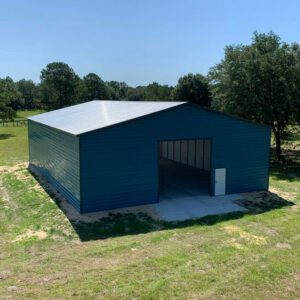Can Metal Buildings Withstand Natural Disasters?
We have all seen the damage that inclement weather can do to homes and other buildings. But are metal buildings immune to this potential devastation?
Let’s take a quick look at metal buildings and natural disasters.
Fire
Let’s start with a crucial aspect of construction – fire resistance. We’ve all seen how devastating forest fires can be, wreaking havoc on towns and structures. To protect against such terrible occurrences, smart construction is essential. That’s where steel comes in as a great building material choice. Its durability, non-combustibility, and fire resistance qualities make it a wise option for areas prone to flames. Unlike wood or vinyl structures that can catch fire or melt, steel framing maintains its structural integrity even under fire exposure when designed and built properly.
Safety measures are also in place to protect metal buildings from fire. The Metal Building Manufacturer’s Association and the Underwriter’s Laboratory have collaborated to create specific standards for steel and other metal building materials. Additionally, the International Building Code provides guidelines for metal buildings and fire safety.
Powerful Winds
Next up, powerful winds – a major concern in the United States, with around 1,300 tornadoes occurring each year. These winds can wreak havoc, completely moving buildings from one place to another. While no “wind-proof structure” exists, metal buildings have an advantage in this situation. Each metal building has a unique wind rating, indicating the force it can endure before breaking. The ductility of metal structures allows them to bend without breaking, reducing wind-related damage. Thanks to steel’s impressive strength-to-weight ratio, metal buildings can withstand powerful winds better than other materials.
Hurricanes
In hurricane-prone areas, metal buildings shine with their ductility and water resistance. Though trees may fall on metal buildings, they usually sustain minor damage compared to other building types that could be destroyed. Even in the worst-case scenario of flooding, the metal’s water resistance ensures there won’t be any lasting structural damage.
Flooding
Floods are becoming more common in the US, making homeowners consider metal constructions. Metal buildings have an advantage over wood structures when it comes to resistance to mold. While mold can wreak havoc on wood, metal buildings can resist corrosion and sustain minimal damage. Additionally, the paint on metal buildings remains intact after a flood, saving money on repainting. Repairs after a flood may only involve replacing a small portion of drywall, carpet, and a few cabinets, while the structure itself remains largely unaffected.
Strong Snow
Heavy snowfall can pose risks to structures, leading to roof collapses and other hazards. Fortunately, well-built metal structures can handle any amount of snow due to their strong support beams, reducing the risk of snow-related damage.
Why Steel Structures Are The Answer
Ductility
When it comes to earthquakes and strong winds, metal structures demonstrate exceptional ductility, meaning they can flex without breaking. This flexibility is crucial in earthquake-prone regions where buildings need to withstand shifting foundations. Steel’s impressive strength-to-weight ratio, which is 25 times higher than that of wood, makes it an excellent choice for areas prone to severe weather conditions.
The Ratio of Strength to Weight
The strength-to-weight ratio is a measure of a material’s ability to sustain its own weight under stress. Steel stands out with the highest strength-to-weight ratio of any building material, making it the most reliable option for enduring extreme weather conditions.
If you’re considering building a metal structure, contact Central Florida Steel Buildings and Supply to ensure your custom building meets all safety standards and environmental requirements, leaving severe weather with no chance..
